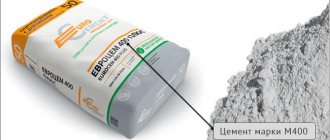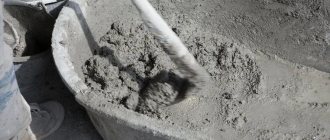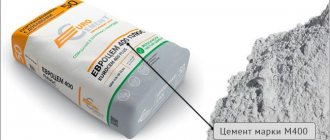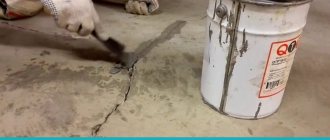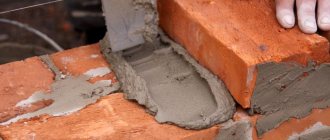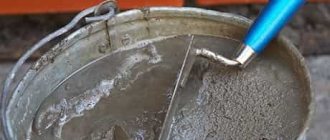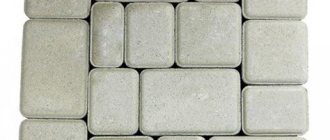Home |Cement |How and with what to paint cement mortar?
Date: November 13, 2018
Comments: 0
Cement mortar is used for construction and repair activities carried out on the inside and outside of the premises. Often the surface needs to be given a marketable appearance and the color changed. What is the best way to paint cement? After all, it is known that the cement composition is distinguished by a grayish tint, which becomes lighter after the moisture evaporates.
Construction specialists know that getting a bright shade of the desired color on such a surface is problematic. You can try to paint the existing surface or use a color for cement mortar.
The first option involves thoroughly cleaning, washing and drying the surface, which should not be wet. The process is labor intensive as white paint is used first and then a second final coat is applied. At the same time, the quality of the dye must ensure resistance to high humidity and ultraviolet radiation.
The second option is more profitable and convenient. The cement pigment introduced into the mixture allows you to obtain any shade. The color for cement must have the following properties:
- Have increased resistance to alkalis.
- Be immune to ultraviolet light.
- Do not dissolve in water.
- Possess good overlap, allowing you to paint over the gray shade of concrete.
It is much more convenient to color the cement mortar at the stage of mixing it.
The complex of these requirements is fully met by iron oxide additives, which, despite the limited range of colors, make it possible to obtain any color shades, many of which are unique. They are used in the industrial production of concrete tiles, tiles and facade products.
What are pigments?
Pigment is a special additive with a powder consistency that is added when mixed into a solution to provide the required color range. It allows you to obtain the desired color in accordance with changes in concentration.
Pigments can be made from mineral raw materials or organic components. Depending on the characteristics of production, they are divided into the following types:
- natural additives obtained by ore mining in deposits;
- synthetic - the result of processing raw materials using chemical reactions used in the production of castings.
In the retail chain, paint for cement mortar is presented in a wide range. You have to choose between dry mixtures, concentrated pastes, microscopic capsules and emulsions. Let's try to figure out how the color range of solutions changes.
The intensity of the resulting color directly depends on the proportions of the additive.
No. 1. Benefits of whitewashing
Whitewashing ceilings and walls is not the most modern way of finishing, and far from the most fashionable. What makes thousands and tens of thousands of people across the country still whitewash in the old fashioned way? Whitewashing has enough advantages:
- low price is the main argument in favor of this type of finishing. When the budget is limited and the room needs to be tidied up, the choice falls on whitewashing. For this reason, hospitals, schools and other government institutions still actively use gypsum and chalk to decorate ceilings and walls;
- ease of application. A person without special training can handle whitewashing - no special skills, abilities or tools are needed;
- neat appearance . Of course, in terms of intricacy and decorativeness, a whitewashed ceiling is inferior to a tension system, and whitewashed walls are inferior to those finished with Venetian plaster, but if you apply whitewash correctly, you can end up with a fresh white surface with an even matte color. If desired, dye can be added to the whitewash solution;
- harmlessness, environmental friendliness , ability to pass moisture and air. Conventional whitewashing in this regard is far ahead of vinyl wallpaper and polystyrene foam ceiling tiles, so in some cases it will be even more preferable;
- Lime whitewash has bactericidal properties , so it will provide additional protection against mold and mildew.
Among the disadvantages are low durability (1-3 years), uncomplicated appearance and dirt during application.
Characteristics of additives for the working mixture
The dye for the solution is diluted using solvents. They are selected depending on the substances contained in the base:
- White spirit dissolves alkyd resins well.
- Water is mixed with acrylic dyes.
- Acetone comes into contact with nitro paints.
- Drying oil interacts with oil-based pigments.
[testimonial_view id=”25"]
Among the main characteristics of pigments are:
- Fraction size is the most important indicator of any dye, characterizing the ability to cover the surface being painted. As the particle size decreases, the reliability of repainting increases;
- sensitivity to light, characterizes the ability of a surface coating to maintain color depth and not fade;
- oil absorption capacity - an indicator that determines the ability of a composition to hold a certain volume of oil;
- alkali resistance determines the ability of the pigment to contact cement;
- hiding power is a characteristic that determines the ability to cover the surface being painted.
Pigments for cement mortar can be organic and mineral, natural and synthetic
Modern paint application technology
Plastered walls intended for painting must first be well dried, since paint does not adhere well to a damp surface and, due to dampness or temperature changes, it bubbles, peels and bounces, which is often observed with poor painting of new buildings.
Painting of cement plaster usually begins no earlier than the next year after the construction of the building. In this case, before painting, new plaster is coated with drying oil so that the oil penetrates as deeply as possible. In cold weather, it is useful to add 5-10% turpentine.
Advantages and disadvantages of colored cement composition
Dyes are widely used for cement surfaces, since after hardening the product does not need to be touched up. As the outer layer wears out, the cement composition retains its original shade.
Let us note important operational characteristics:
- Safety of supplements for health.
- Economical in use. A small concentration of the substance allows you to obtain a rich color range.
- Wide possibility of achieving different color shades by changing the concentration of additives.
Despite many positive aspects, there are negative aspects. The composition, colored with the help of additives, loses its original color over time and acquires a yellowish tint. The costs of installing a colored concrete surface are quite significant.
Padding
Treating the concrete surface with a primer or primer allows you to remove dust and improve further adhesion. Priming You can use latex, epoxy, or polyurethane composition. Before using the mixture, you must carefully study the manufacturer's instructions. The procedure is carried out using a roller or spatula. The solution is applied generously; if the base is weak, then it is primed in two layers, without gaps. Areas of the floor along the walls and corners must be treated especially carefully with a brush. After applying the composition, you need to wait until it dries completely, after which you can begin applying the enamel. For drying, the room temperature should be in the range of 18-24℃.
Methods for coloring cement mortar
How is the working mixture painted? The process of obtaining colored concrete is more preferable. It allows for uniform painting of the entire array, ensuring the preservation of the color scheme even with significant wear of the surface layer.
Used in the industrial production of concrete products (colored concrete tiles and tiles, facade and interior finishing materials)
Color depth is achieved by introducing a significant amount of pigment, which is expensive. Using this method, you will forget about the need to update the cement surface for a long period.
The technological process of giving the cement mortar the required color is carried out in the following ways:
- one specific pigment is added to a cement-based composition intended for pouring a floor or making products;
- compositions of different color shades are poured into the mold. The method is used for single production of concrete products with decorative properties;
- various additives with shades of the same color range are mixed in the general mixture in low concentration, which makes it possible to provide the texture of the stone with veins;
- coating the pouring mold before filling with mortar.
No. 3. How to determine what was used for whitewashing?
Probably everyone has heard at least once in their life that different whitewashes cannot be mixed. If lime whitewash was applied to the ceiling or wall, then when installing chalk whitewash on top, you will soon be able to see unsightly stains. When preparing a room for finishing and assessing the condition of surfaces, it is very important to determine what whitewashing was done before.
The check is very simple. It is enough to wet a small fragment of the finish with water and observe the reaction. Wet lime will darken a little, and if you rub the surface with your finger, there will be no white marks left on your hands.
Process of painting concrete after curing
Many developers who have not encountered painting concrete are interested in how to paint the cement mortar after it has set, dried and acquired the required hardness?
There is also a water-based liquid acid dye for sale for concrete mixtures, often used for private repairs.
This possibility exists and is used to cover ready-made, monolithic structures made of ordinary and reinforced concrete. The method is the process of applying a layer of paint to the surface of the finished product. A special composition must be used that penetrates deeply into the pores of the concrete surface. The composition forms a coating on the concrete product and penetrates into the concrete mass by more than 5 mm.
The technology has proven itself positively when painting large areas and performing facade work. The preservation of the color of a concrete product is determined by the ability of the substance to penetrate deeply into the base and its hydrophobicity (moisture resistance) after hardening.
With increasing depth of penetration of the composition containing pigment dye, the service life and color saturation of the surface increases. After all, the top layer will be under the influence of natural factors that have a detrimental effect on most coloring compositions.
The ability to resist abrasion is an important point. As the top layer wears, the paint will be removed. That is why manufacturers of paving slabs paint the cement mixture, and not the finished product.
Useful tips
Despite the fact that there is nothing particularly difficult about painting concrete walls, there are some useful tips that will help you avoid serious mistakes and get the job done efficiently from start to finish:
- It is necessary to prime the wall. This will not only improve the quality of work, but also increase the service life of the paint;
- if holes or through openings are made in the wall, the exposed reinforcement needs additional processing;
- if there are areas on the wall that are covered with mold, you must first remove it and only then paint it;
- In no case should you apply paint without putty or plaster - after all, the wall must be leveled;
- You should make sure that there are no stains of grease, rust, etc. on the wall, otherwise they will show themselves, even despite several layers of paint.
Making your own dye
How to paint a concrete product to preserve the breathability of the base and, at the same time, make it difficult for destructive moisture to penetrate. You can buy ready-made chloride-based paint for concrete products, or mix the following components yourself:
- Process water in a volume of 7 liters.
- Dry lime pigment in the amount of 500 grams.
Like any other concrete, colored mortar will turn yellow over time.
- Hydrated lime – up to 1.5 liters.
- Calcium chloride – 250 grams.
- Regular laundry soap - 0.03 kg.
It is necessary to quench the lime in half a bucket of water and, using 1 liter of the composition, dilute the dye. Using the second liter of slaked lime, prepare a solution of laundry soap. Mix them in a common container and strain the resulting dye from undissolved particles.
The dye is a liquid that flows easily down a vertical surface and does not come into contact well with the porous surface of the cement. The problem is easily solved by using an acid-based gel additive.
How to prepare acid dye for cement? Prepare the following ingredients:
- adhesive base;
- special coloring additive;
- solvent;
- additional substances, the introduction of which helps to consolidate the result.
Mix the components until a homogeneous consistency is obtained. Add dye with the chosen pigment. When painting with acid dyes, use safety glasses, work clothes and rubber gloves.
Possibility of obtaining various shades and colors by proportionally mixing basic shades and additives
No. 6. How to whitewash the ceiling and walls: brush, roller or spray?
Theoretically, whitewash can be applied using the following tools:
- brush;
- roller;
- spray gun;
- vacuum cleaner with air blowing function.
Let us immediately note that the first two options are more applicable - using a vacuum cleaner and a spray gun makes sense when there is a large surface area that needs to be whitened.
A brush for whitewashing is taken with a special one, made of natural bristles, 15-20 cm wide. After work, the brush can be washed and used again later. To whitewash a brick wall, you can use a brush with natural bristles. It is advisable to soak it in water several hours before use. In this case, the wooden handle swells a little and holds the bristles well, which will not fall out during the whitewashing process.
Before applying the mixture, it is important to mix it well again to ensure an even shade. The first layer is applied perpendicular to the window, the second – parallel to the frames. In this case, the streaks from the brush will be minimally noticeable. Experts recommend slightly moistening the surface of the ceiling and walls before applying the mixture.
It is better not to use a whitewash roller. When there is only one layer, this tool will still work, but when applying the second layer, the dried first one may fall off. If you act carefully, you can get a beautiful matte surface.
A sprayer and a vacuum cleaner are used only when there is a large surface to be finished. The consumption of the solution increases, it is applied in a thicker layer, but it will be possible to mask small defects. If you have a sprayer at your disposal, then no questions arise.
You can also apply whitewash with a vacuum cleaner if it has an air blowing function. Among the numerous attachments in such models there should be a polyethylene lid with tubes. This cap is the sprayer. It must be put on the can and connected with a hose to the outlet in the vacuum cleaner. It turns out that when you blow out air with a vacuum cleaner, the air enters the sprayer, draws the solution from the can and sprays it through the nozzle. As a rule, there is a special hole on the sprayer, covering which you can obtain the required solution supply pressure. It is better to apply the solution in a circular motion, spraying at a distance of 70-100 cm.
Which cement is preferable for painting?
The technological process for producing colored concrete products allows the use of any brand of cement. Remember that the initial color of the cement determines the shade of concrete that will be obtained as a result of painting.
Use different grades of cement according to the recommendations:
- Portland cement, which is distinguished by its gray color, after hardening acquires a gray, dirty tint, muting the bright colors.
- White cement has less effect on the color change of the product after hardening and can be used to achieve a rich and bright palette of light concrete colors.
Depending on the type of pigment used, the degree of saturation and depth of shade change. Performing a preliminary batch and pouring a test batch of the composition allows you to determine the color scheme of the future product.
Remember that exceeding the concentration of pigments in the cement mortar causes the formation of cracks and peeling in the finished product, which is associated with increased absorption of moisture by the pigment and disruption of the hydration process. Using special additives aimed at retaining moisture and plasticizers allows you to avoid negative aspects.
The mixtures used must have high abrasion resistance
Colored cement, dye (paint, pigment) for cement, mortar and concrete at home
Colored cement is concrete painted in one shade or another, using various pigments and techniques. Typically, pure concrete structures have a dull gray color, which is provided by the cement included in the composition. But there are times when concrete needs to be given a different shade or color - in this case, pigments are used.
Colored concrete is used to create paving slabs, various types of paving stones, side stones, stairs, curbs, enclosing structures, decorative sculptures, etc. The popularity of color compositions is growing every day, and therefore new cement paints, methods and methods of coloring, technologies and options are appearing.
Selecting a shade
By using different pigments in certain percentages, you can get a wide palette of colors. Most used colors:
- white, formed by titanium dioxide;
- green, formed by chromium oxide;
- red, obtained by reaction with red iron oxide;
- yellow, based on yellow iron oxide;
- black, obtained by mixing with black iron oxide.
This is not a complete list of dyes that can be used to change the color of the cement composition.
Recommendations
When painting, follow the recommendations of professionals:
Painting cement mortar intended for brickwork provides an original effect. Improved perception of masonry is achieved due to the contrast of the seams with the color of the material. Use quartz to obtain white joints used when laying sand-lime bricks. Use black and brown iron oxides for ordinary red brick.
When performing work on painting a cement surface, follow the technology. If in doubt, it is better to invite professionals! They will help you purchase the necessary additive, prepare the solution correctly and paint the concrete efficiently.
Source
Recommendations
Regardless of whether you are painting plaster, masonry mortar, concrete for pouring, or a ready-made monolith, you need to remember some important nuances.
Colored cement is a great opportunity to give any structures and surfaces a decorative look and individuality. Provided that high-quality pigments are used and technology is followed, concrete coloring will not only achieve the desired effect, but also strengthen the monolith itself and improve its performance characteristics.
Source
